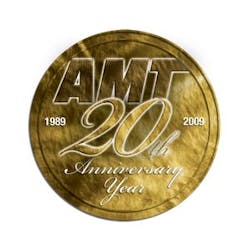Getting AMT Off the Ground
In 1986 Johnson Hill Press, now Cygnus Business Media, launched FBO magazine, which would in time become Airport Business (AB) magazine. John Infanger, current editor of AB, became familiar with FBOs and repair stations and helped identifiy the opportunity for a maintenance magazine.
Infanger says that by the time the original team looked to launch the magazine, less than 100 new aircraft were being produced yearly. Infanger and the startup team identified the opportunity for a maintenance magazine as they watched the industry change from its focus on new aircraft to focusing on maintaining a fleet.
“At the time, Aviation Maintenance was out and had been for a few years,” says Infanger. “Then there was Aircraft Mechanics Journal. That’s where we met Kathy. We hired her away to get someone well-versed in the maintenance arena.”
Kathy Marr, then Kathy Bailey, came on board in 1989 as associate publisher. Mike Murrell was the original publisher, a title Marr earned within a year. “Mike Murrell and I designed the original plans for the magazine on a cocktail napkin,” she says.
“We took all our lessons learned and with Kathy and Mike as the lead people, launched Aircraft Technician,” says Infanger. His own role in the launch of Aircraft Technician was to help guide the editorial product and find an editor. After the hire of Greg Napert as editor, Infanger became editorial director.
The vision
“We went out and interviewed the audience, asking them what they were getting or not getting and what they needed,” says Infanger. “We then took this to potential advertisers and asked them what they thought was on readers’ minds.”
“We wanted a product that could be a champion for the maintenance community,” says Marr, who was with AMT for 15 years. “We wanted it to be highly respected and regarded and No. 1. It was about building the status of the community and promoting it.
“There was such a shortage of technicians at the beginning,” says Marr. “Another major issue was how to get people into school, and how to keep them in the field.”
While Marr had previously worked for another aircraft maintenance magazine, she says she had no mechanical aptitude to begin with. “I got my maintenance background by osmosis,” she says. “I’d go work in the hangar or on the flight line to get some first-hand experience. I even did some work with Tom Hendershot down at Frontier. Through doing all that, I got the idea beyond what I could read and absorb.”
“We thought that despite the fact there were pubs out there, we could have an impact and be a positive force from an informational standpoint,” says Infanger. “We have been and we continue to be.”
The legacy
Marr, who considers herself the magazine’s mother, says she is most proud of the fact that she helped to develop a credible magazine. Her fondest memory of her days with AMT was the day the first issue came off the press. “That was a little bit like seeing a newborn for the first time,” she says. “It was a powerful moment for me. We had worked so hard and so long and took such a gamble.”
In 1993 the Aircraft Technician team recognized some changes going on in the industry and looked to change the name of the magazine accordingly.
“One of the things FAA wanted to do was to call mechanics aircraft maintenance technicians,” says Infanger. “We relaunched the magazine so that when the FAA came out with its new regs we would already be called AMT.”
The gamble undertaken by Infanger, Marr, and Murrell paid off in positive response from the magazine’s readers. Infanger says that during Aircraft Technician’s and later, AMT’s early years, the magazine generated more letters and correspondence than any other magazine at the company.
“The readers are passionate about their industry and their commitment,” he says. “It’s a very active audience. We noticed it immediately.”
Though AMT has seen many changes during its 20 years, its core reason for being remains.
“There will always be a need to communicate positive messages about maintenance and to keep recurrency training at the forefront,” says Marr. “AMT is still very relevant to its readership.”
“Today we’re making a lot more airplanes, there’s a whole bunch of healthy FBOs out there and the industry has expanded,” says Infanger. “There’s still a lot of techs and a need for good information for those techs.”
Though Marr left AMT in 2003, she likens her experiences with the magazine to that of a first love. To those who read “her baby” every month, Marr says, “Keep striving to be the best you can be and keep those planes flying!”
